Your SlideShare is downloading.
×
×

Saving this for later?
Get the SlideShare app to save on your phone or tablet. Read anywhere, anytime - even offline.
Text the download link to your phone
Standard text messaging rates apply

Like this presentation? Why not share!
-
Ppt On S.Q.C. by dvietians 21034 views
-
Statistical quality control by Anubhav Grover 1620 views
-
Introduction To Statistical Quality... by Siddharth Nath 35807 views
-
Statistical Quality Control by Professor (Dr.)Ra... 1705 views
-
Introduction to Statistical Quality... by Sixsigmacentral 2665 views
-
Statistical process control by maxfactorstorm 1014 views
-
Statistical Process Control by Siddharth Nath 10549 views
-
Introduction to statistical quality... by Armando Morales 7087 views
-
Statistical Process Control & Cont... by svermatn 7445 views
-
Statistical Process Control by Marwa Amra 3904 views
-
Control charts by Mohit Singla 2565 views
-
Statistical process control by Anoopa Narayan 2624 views
Like this? Share it with your network
Share
Statistical Quality Control.
14,207
views
views
Published on
Brief explanation of contetnt through examples.
Brief explanation of contetnt through examples.
No Downloads
Views
Total Views
14,207
On Slideshare
0
From Embeds
0
Number of Embeds
1
Actions
Shares
35
Downloads
438
Comments
7
Likes
17
Embeds
0
No embeds
No notes for slide
Transcript
- 1. StatisticalQualityControlBY: ANKITA, REENA, RAVIRAJ & CHETAN.1
- 2. What is SQC ?Statistical quality control (SQC) is theterm used to describe the set ofstatistical tools used by qualityprofessionals.2
- 3. History SQC was pioneered by Walter A. Shewhart atBell Laboratories in the early 1920s. Shewhart developed the control chart in 1924 andthe concept of a state of statistical control. Shewhart consulted with Colonel Leslie E. Simon inthe application of control charts to munitionsmanufacture at the Armys Picatinney Arsenal in1934.3
- 4. History W. Edwards Deming invited Shewhart to speak at theGraduate School of the U.S. Department of Agriculture, andserved as the editor of Shewharts book Statistical Methodfrom the Viewpoint of Quality Control (1939) whichwas the result of that lecture. Deming was an important architect of the qualitycontrol short courses that trained American industry inthe new techniques during WWII.4
- 5. Deming traveled to Japan during the Allied Occupation and metwith the Union of Japanese Scientists and Engineers(JUSE)in aneffort to introduce SQC methods to Japanese industry5
- 6. SQC Categories6
- 7. Descriptive Statistics Descriptive statistics are used todescribe quality characteristicsand relationships.7
- 8. Descriptive Statistics The Mean- measure of central tendency The Range- difference between largest/smallestobservations in a set of data Standard Deviation measures the amount ofdata dispersion around mean8
- 9. The Mean To compute the mean we simply sum all the observations anddivide by the total no. of observations.9
- 10. The Range Range, which is the difference betweenthe largest and smallest observations.10
- 11. Standard Deviation Standard deviation is a measure of dispersion of acurve. It measures the extent to which these values arescattered around the central mean.11
- 12. • Extend the use of descriptive statistics to monitorthe quality of the product and process• Statistical process control help to determine theamount of variation• To make sure the process is in a state of controlStatistical processcontrol1212
- 13. Variation in Quality No two items are exactly alike. Some sort of variations in the two items is bound to be there. Infact it is an integral part of any manufacturing process. This difference in characteristics known as variation. This variation may be due to substandard quality of rawmaterial, carelessness on the part of operator, fault inmachinery system etc..13
- 14. Types Of Variations14
- 15. Variation due to chancecauses/common causes Variation occurred due to chance. This variation is NOT due to defect in machine, Rawmaterial or any other factors. Behave in “random manner”. Negligible but Inevitable The process is said to be under the state of statisticalcontrol.1515
- 16. Variation due to assignablecausesNon – random causes like:Difference in quality of raw materialDifference in machinesDifference in operatorsDifference of time1616
- 17. 17
- 18. Specification and control limits No item in the world can be a true copy of another item. It is not expressed in absolute values but in terms of a range. For Eg:The diameter of a pen is expected by itsmanufacturer not as 7mm but as 7mm ± 0.05.Thus, the diameter of a pen produced by themanufacturer can vary from 6.95 mm to 7.05 mm.18
- 19. Setting Control Limits19
- 20. HOW CONTROL LIMITS AREUSEFUL…..?20
- 21. SPC Methods-Control Charts Control Charts show sample data plotted on agraph with CL, UCL, and LCL Control chart for variables are used tomonitor characteristics that can be measured, e.g.length, weight, diameter, time Control charts for attributes are used tomonitor characteristics that have discrete valuesand can be counted, e.g. % defective, number offlaws in a shirt, number of broken eggs in a box21
- 22. Control Charts for Variablesx-bar chartsIt is used to monitor the changes in the mean of aprocess (central tendencies).R-bar chartsIt is used to monitor the dispersion or variability of theprocess22
- 23. Constructing a X-bar chart( sigma is not given) A factory produces 50 cylinders per hour. Samples of 10cylinders are taken at random from the production atevery hour and the diameters of cylinders are measured.Draw X-bar and R charts and decide whether theprocess is under control or not.(For n=4 A2= 0.73 D3= 0, D4=2.28)23
- 24. Sampleno.x1 x2 x3 x41 230 238 242 2502 220 230 218 2423 222 232 236 2404 250 240 230 2255 228 242 235 2256 248 222 220 2307 232 232 242 2428 236 234 235 2379 231 248 251 27110 220 222 224 23124
- 25. Sampleno.x1 x2 x3 x4 SigmaXiMeanX-barRangeR1 230 238 242 250 960 240.00 202 220 230 218 242 910 227.50 243 222 232 236 240 930 232.50 184 250 240 230 225 945 236.25 255 228 242 235 225 930 232.50 176 248 222 220 230 920 230.00 287 232 232 242 242 948 237.00 108 236 234 235 237 942 235.50 39 231 248 251 271 1001 250.25 4010 220 222 224 231 897 224.25 11Total 2345.75 19625
- 26. Calculation of x-bar and R-bar Now,75.2341075.2345mxx6.1910196mRR26
- 27. 27Factor for x-ChartA2 D3 D42 1.88 0.00 3.273 1.02 0.00 2.574 0.73 0.00 2.285 0.58 0.00 2.116 0.48 0.00 2.007 0.42 0.08 1.928 0.37 0.14 1.869 0.34 0.18 1.8210 0.31 0.22 1.7811 0.29 0.26 1.7412 0.27 0.28 1.7213 0.25 0.31 1.6914 0.24 0.33 1.6715 0.22 0.35 1.65Factors for R-ChartSample Size(n)
- 28. Control limits of X-BarChart Central line C.L = U.C.L ==234.75 + (0.73) (19.6)=249.06 L.C.L==234.75- (0.73) (19.6)=220.72RAx *2RAx *275.234x28
- 29. X-Bar Chart29
- 30. Control limits of R-BarChart Central Line = U.C.L ==45.50 L.C.L ==06.19R)96.19(*)28.2(4RD)96.19(*)0(3RD30
- 31. R-Bar Chart31
- 32. Constructing a X-bar Chart(Sigma is given) A quality control inspector at the Coca-Cola soft drinkcompany has taken twenty-five samples with four observationseach of the volume of bottles filled. The data and thecomputed means are shown in the table. If the standarddeviation of the bottling operation is 0.14 ounces, use thisinformation to develop control limits of three standarddeviations for the bottling operation.32
- 33. 33
- 34. Equations342dRsnsxxzXLCLxzXUCL
- 35. 35
- 36. X-Bar Control Chart36
- 37. Control Charts for Attributes Attributes are discrete events; yes/no, pass/failUse P-Charts for quality characteristics that arediscrete and involve yes/no or good/bad decisions Number of leaking caulking tubes in a box of 48 Number of broken eggs in a cartonUse C-Charts for discrete defects when there canbe more than one defect per unit Number of flaws or stains in a carpet sample cut from aproduction run Number of complaints per customer at a hotel37
- 38. P-Chart Example A Production manager of a BKT tire company hasinspected the number of defective tires in five randomsamples with 20 tires in each sample. The table belowshows the number of defective tires in each sample of 20tires. Calculate the control limits.38
- 39. 39
- 40. 40
- 41. P- Control Chart41
- 42. C - Chart Example The number of weekly customer complaints aremonitored in a large hotel using a c-chart. Developthree sigma control limits using the data table below.42
- 43. 43
- 44. 44
- 45. C - Control Chart45
- 46. Process Capability Evaluating the ability of a production process to meet orexceed preset specifications. This is called processcapability. Product specifications, often called tolerances, arepreset ranges of acceptable quality characteristics, suchas product dimensions.46
- 47. Two parts of process capability 1) Measure the variability of the output of a process, and 2) Compare that variability with a proposed specification orproduct tolerance.47
- 48. Measuring Process Capability To produce an acceptable product, theprocess must be capable and in controlbefore production begins.486LSLUSLCp
- 49. Example Let’s say that the specification forthe acceptable volume of liquid ispreset at 16 ounces ±.2 ounces,which is 15.8 and 16.2 ounces.49
- 50. Figure (a) The process produces 99.74 percent (three sigma) of theproduct with volumes between 15.8 and 16.2 ounces.501pC
- 51. Figure (b) The process produces 99.74 percent (three sigma)of the product with volumes between 15.7 and 16.3ounces.511pC
- 52. Figure (c) the production process produces 99.74 percent (threesigma) of the product with volumes between 15.9 and16.1 ounces.521pC
- 53. 53
- 54. 54
- 55. Process capability ratio(off centering process) There is a possibility that the process mean may shift over aperiod of time, in either direction, i.e., towards the USL or theLSL. This may result in more defective items then the expected.This shift of the process mean is called the off-centering of theprocess.553,3minLSLUSLC kp
- 56. Example56 Process mean: Process standard deviation: LSL = 15.8 USL = 16.29.15067.01)067.0(64.0pC
- 57. 573,3minLSLUSLC kp33.033.0,00.1min)1(.38.159.15,)1(.39.152.16minpkpkkpCCC
- 58. Thank You…58
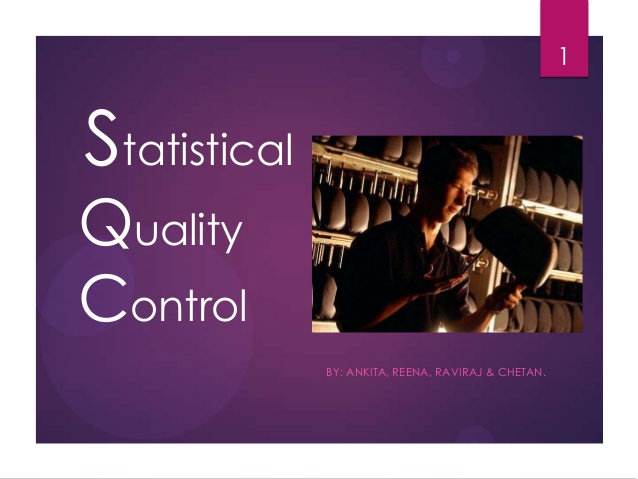

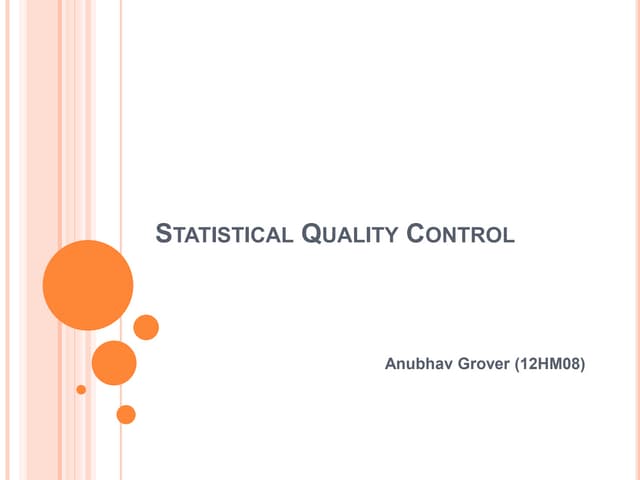






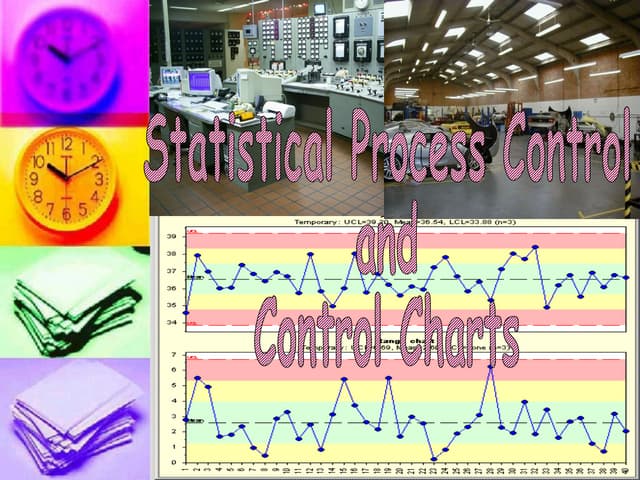

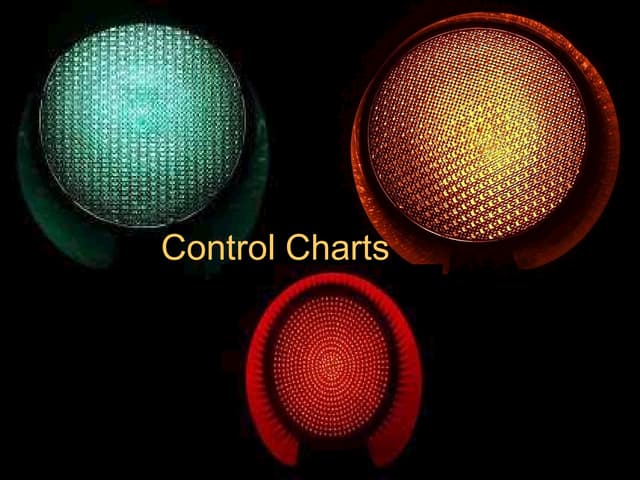
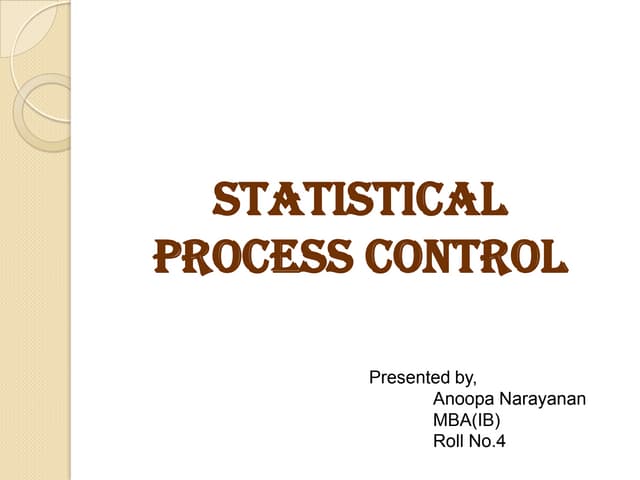


Thanks much in advance!
Thank you :)